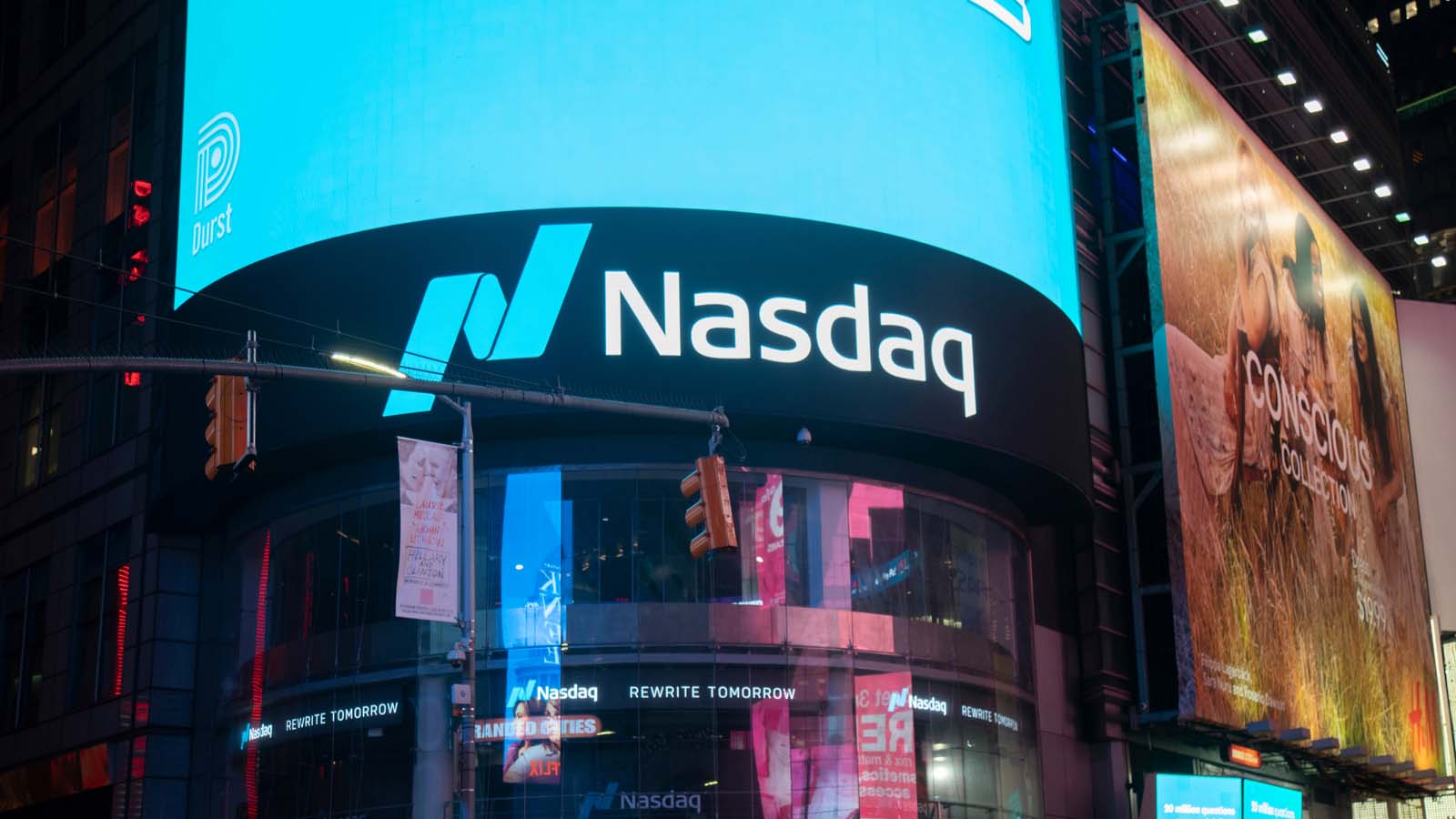
How the Nasdaq 100 rebalance will impact stocks … why yesterday’s retail sales report was better than it seemed … homebuilder confidence keeps growing … our ITB trade hits a high
The gains from Big Tech have grown so lopsided this year that the Nasdaq 100 is about to hold a “special rebalance” for the first time in 25 years.
As you’re aware, Wall Street has gone crazy for tech/AI in 2023. Torrents of capital have flooded a handful of stocks, resulting in seven largest holdings in the Nasdaq 100 now accounting for 55% of the performance of the entire index (we’re lumping both Alphabet equity classes together).

The whole point of buying an index is to get broad exposure – though I doubt any Nasdaq 100 investors are complaining.
The chart below (slightly dated, from June) shows the “Magnificent 7” stocks (which are basically the heaviest weighted stocks in the Nasdaq 100) crushing the rest of the market this year.

The weighting has become so lopsided that this special rebalance is now the solution
For more, let’s go to legendary investor Louis Navellier. From yesterday’s Accelerated Profits issue:
This dominance triggered action by the NASDAQ that has only happened two other times.
The NASDAQ announced a special rebalance for the NASDAQ 100 index to “address over concentration in the index by redistributing the weights” of Amazon, Apple, Google, Meta Platforms, Microsoft, NVIDIA and Tesla.
Now, it’s important to note that this isn’t a traditional “rebalance” in that there won’t be any additions or deletions to the NASDAQ 100. Rather, weightings will be redistributed in an effort to keep the NASDAQ 100 in compliance with the SEC diversification rule. This rule limits the aggregate weight of the largest stocks with 5% or more weights to 50%.
Louis explains that NASDAQ will trim the weight of these seven gigantic tech stocks and spread that weighting across the other 93 stocks in the NASDAQ 100. The changes will be effective this coming Monday, July 24.
Here’s a graphic with more details:

Back to Louis for the practical impact on your portfolio:
…We will likely see more institutional buying pressure in other NASDAQ 100 stocks, while these mega-cap stocks lose a little bit of their mojo in the upcoming weeks. In other words, the stock market will continue to broaden out.
As to that “lost mojo,” after the rebalance, the collective weight of these seven stocks will fall from today’s 55% to 44%.
Meanwhile, yesterday brought a retail sales report that Louis says is better than it first appears
Here’s the MarketWatch with the overview of the report’s findings:
Sales at retailers rose a tepid 0.2% in June, reflecting a shift in consumer spending habits and signaling softness in some parts of the U.S. economy.
Sales had been forecast to increase 0.5%, based on a Wall Street Journal poll of economists. The shortfall stemmed in large part from a decline in spending at gas stations.
Despite the shortfall, Louis sees strength in the details of the report. Let’s jump to yesterday’s Special Market Update podcast from Accelerated Profits:
[The report] doesn’t look good on the surface, but under the surface it’s much better…
The real problem with June retail sales coming in below expectations is that sales at grocery stores fell 0.7% and gas station sales fell 1.4%. Consumers spend a lot of money on gas and food. So, when you strip that out, it looks a lot better.
A good example – online sales went up 1.9% in June… furniture sales rose an impressive 1.4%… electronics and appliance sales, which had been weak in previous months, rose 1.1% in June… so there are some green shoots out there, folks.
And retail sales rose every month in the second quarter. So, we’re growing because we’re a consumer-driven economy.
Speaking of the consumer, I’ll add that last Friday’s University of Michigan Consumer Sentiment Index revealed the most optimistic consumer since September 2021.
Here’s Yahoo! Finance:
The first July reading of the University of Michigan Consumer Sentiment Index showed a reading of 72.6 on Friday. The print came in significantly higher than the 65.5 economists had expected and reflected a 13% increase from the month prior. That marks the fastest pace since December 2005, when the economy was recovering from Hurricane Katrina.
“The sharp rise in sentiment was largely attributable to the continued slowdown in inflation along with stability in labor markets,” Surveys of Consumers director Joanne Hsu said in the release.
This is big news. As Louis pointed out, we have a consumer-driven economy. To the extent that consumers remain confident and continue spending, the economy will continue to chug along.
Finally, confidence isn’t just rising for consumers – optimism continues building for U.S. homebuilders
Yesterday’s National Association of Home Builders/Wells Fargo Housing Market Index showed builder sentiment for single-family homes rose 1 point in July to a reading of 56.
Here’s more from CNBC:
It marks the seventh straight month of gains and the highest level since June 2022. A reading above 50 is considered positive sentiment.
Builders say low supply in the resale market is driving demand for new construction, but higher mortgage rates and supply-side challenges continue to put pressure on the market.
I’m not sure I see the pressure they’re referencing.
As we’ve pointed out here in the Digest, frustrated would-be homebuyers are begrudgingly accepting 6% – 7% mortgage rates. This is leading to more buyers stepping back into the market, putting renewed, upward pressure on home prices (plus, a return to bidding wars).
Even in the same article that just referenced “pressure on the market,” CNBC notes:
Despite higher mortgage rates, however, builders are using fewer incentives. Just 22% of builders reported cutting prices in July. This is down from 25% in June and 27% in May.
Why cut prices when homebuyers are fighting it out in bidding wars?
While this isn’t great news for would-be homebuyers, it’s fantastic for investors in homebuilding stocks.
On that note, our ITB trade just hit a fresh high
In our April 20, 2022, Digest, we suggested that aggressive investors could jump into an iShares Home Construction ETF (ITB) trade. ITB holds homebuilding heavyweights including DR Horton, Lennar, NVR, Pulte, and Toll Brothers.
We’re up big in the trade, and the gains keep coming.
As you can see below, ITB is up 51% since our recommendation, compared with the S&P’s 2.6% gain over the same period. Better still, you can see the returns accelerating this summer.

While we expect more gains to come for ITB, if you’re considering jumping into the trade, keep an eye on its Relative Strength Index (RSI) level.
The RSI is a momentum indicator that measures the extent to which an asset is overbought or oversold. A reading over 70 suggests an asset is “overbought” (which increases the odds of a mean-reversion pull-back) while a reading below 30 means it’s “oversold” (which increases the odds of mean-reversion gains).
Traders often reference a stock’s RSI to help time entries and exits.
As you can see below, ITB’s RSI is clearly overbought, which suggests upcoming price weakness or a stretch of sideways consolidation.

So, if you want to jump into the trade, just be aware there’s elevated potential for a better entry price in the coming days/weeks.
Bigger picture, the structural imbalances in the housing market will continue to support profits for homebuilding companies looking forward
Until the Fed begins cutting rates, which translates into lower home financing costs that lure existing homeowners back into the market, existing housing inventory will remain near record lows.
On that note, yesterday brought news that real-estate brokerage Redfin has found out of every 1,000 homes in the U.S., only 14 changed hands over the first six months of 2023.
That’s a turnover rate of just 1.4% – the lowest share in a decade.
In this environment, would-be homebuyers have little recourse other than to turn to new construction.
Invest accordingly.
Have a good evening,
Jeff Remsburg






